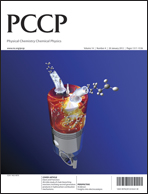Spin–orbit effects on a gold-based superatom: a relativistic Jellium model
Abstract
The inclusion of relativistic effects always brings to the scientific community great and stimulating surprises. To consider the spin–orbit term, which accounts for the interaction between the spatial and spin coordinates, requires the use of double point groups of symmetry in order to solve the Dirac equation or the two component approximation to it, leading to total angular momenta (j) functions, atomic or molecular spinors, instead of pure orbital angular momenta ( ), atomic or molecular orbitals. Large and small components, derived from the Dirac treatment, depict wavefunctions corresponding to
), atomic or molecular orbitals. Large and small components, derived from the Dirac treatment, depict wavefunctions corresponding to


 Please wait while we load your content...
Please wait while we load your content...